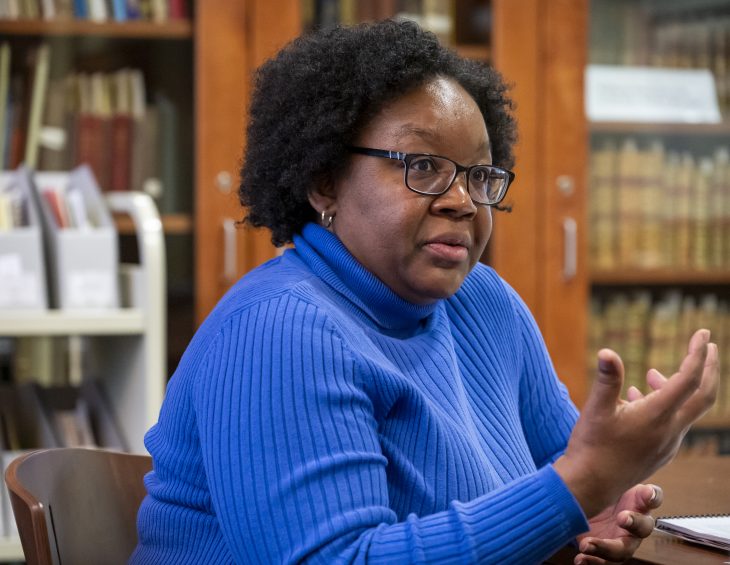Launched by The University of the South, the Locating Slavery's Legacies database helps create the conversation on the importance of understanding the legacy of slavery in higher education institutions.
Elon University has been working in collaboration with a group of universities that is documenting Civil War memorials and monuments on campuses across the South to better understand their impact on higher education.
 The Locating Slavery’s Legacies database is a project initiated and overseen by The University of the South in Sewanee, Tennessee. The university began this work in 2017 and the database is now part of its Roberson Project on Slavery, Race, and Reconciliation.
The Locating Slavery’s Legacies database is a project initiated and overseen by The University of the South in Sewanee, Tennessee. The university began this work in 2017 and the database is now part of its Roberson Project on Slavery, Race, and Reconciliation.
The database project expanded in 2022 with a pilot phase designed to partner with other institutions already undertaking the important work of examining their histories related to race and slavery. “They invited schools like Wofford, Meredith, William & Mary, Virginia Military Institute and Furman — Southern region colleges and universities that were already doing this work,” said Shaunta Alvarez, digital collections and systems librarian, who has taken a leading role in Elon’s partnership with the project.
Elon University in August 2018 began an effort that would become the Committee on Elon History and Memory and has focused on exploring questions related to historical memory and collective identity at the university. Elon does not have Confederate memorials or monuments on its campus, but its history and memory work positioned the university to play a role in the Locating Slavery’s Legacies project, with Alvarez leading the collaborative effort beginning in June 2022.
Everyone involved in creating the database is very passionate about the work, and the updated database is expected to be launched for the public later this year, Alvarez said. “The goal of the database is for each school to create its own site where they talk about their memorials,” Alvarez said.

Since the launch of the pilot phase, collaborators from the participating universities and colleges have gathered monthly on Zoom on Friday mornings to advance the work on the database. The backend work and the framework for the database had already been completed before Elon and the other schools joined the effort. They have been guided by a data dictionary that defines all the information that is being put into the database. The meetings offered guidance to those doing the work, which has included uploading elements or answering questions about whether something is suitable for inclusion.
Students from the partner schools have also played a role including uploading information, reading histories and more. There is high value in involving students in the conversation, Alvarez said.
“Teaching students how to do research about their school and learn the legacy of whether it’s influenced by slavery, or not” is important, she said. “It’s their school and they become a member of the community. They deserve to know.”
Elon has contributed to the database information around many of the people, policies and histories detailed in the Committee on Elon History and Memory’s 2020 report and recommendations. The report detailed 10 episodes that illustrate both anti-Black racism and Black achievements that have been only partially told or erased. Added to the database are details about the legacy of William A. Harper, Elon’s fourth president whose name was removed from a residential building in 2020 due to racist behavior, to current efforts to diversify the curriculum. The database has more information about the first black student, Glenda Phillips, the Phillips Perry Black Excellence Awards, and an on-campus monument to the Rev. James O’Kelley, the founder of the Christian Church, which founded Elon, and who advocated against slavery. Visitors to the database can also the history behind the Janice Ratliff building. Ratliff, who came to Elon in 1981, served for 35 years and became the first Black Elon staff member to have a building named in her honor.

Sometimes confronting the negative impact of segregation on families can lead to healing and understanding, Alvarez said. There needs to be an openness and willingness to discuss the complexities of history, as well as the potential for healing and reconciliation through educational initiatives and public history projects. “If there’s a willingness to see the history as it is, there can be a point of healing,” she said.
The potential impact from healing, reconciliation and moving forward from painful portions of the country’s past is why the Locating Slavery’s Legacies database is so important. Alvarez said we should encourage people to always ask questions and learn about history, she said.
“Asking questions about people mentioned in street names gives a better understanding on the history and significance of these locations,” Alvarez said.
Alvarez sees room for The Locating Slavery’s Legacies database project to expand to something even greater in the future.
“I can see people going on virtual tours, visiting each other’s campuses to see these monuments,” she said. “I could see us doing a tour of partner colleges and hosting conferences at those different places.”


